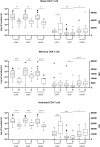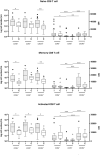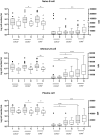Infant respiratory infections modulate lymphocyte homing to breast milk
- PMID: 39867906
- PMCID: PMC11757141
- DOI: 10.3389/fimmu.2024.1481416
Infant respiratory infections modulate lymphocyte homing to breast milk
Abstract
Introduction: Chemokines and their receptors are essential for leukocyte migration to several tissues, including human milk. Here, we evaluated the homing of T and B lymphocyte subsets to breast milk in response to ongoing respiratory infections in the nursing infant.
Methods: Blood and mature milk were collected from healthy mothers of nurslings with respiratory infections (Group I) and from healthy mothers of healthy nurslings (Group C). Total lymphocyte, T and B cells, their subset numbers, and the expression of the homing receptors CCR5, CCR6, CCR10, and CXCR3 in these cells were evaluated in milk. Maternal serum and milk chemokine, cytokine, and IgA and IgG antibody levels were also quantified.
Results: All milk lymphocyte numbers were greater in Group I than in Group C. All CD4 T-cell subsets expressing CCR5, CCR6, and CXCR3 were higher in Group I. Within the CD8 T-cell subsets, only CCR6 and CXCR3 were higher in Group I, while CCR5 expression was higher in Group I exclusively for activated CD8 T cells. Group I showed greater numbers of all CCR6+ B-cell subsets and CXCR3+ naive B cells and plasma cells than did Group C. Infection of the nurslings promoted increased CCL20, CXCL10, IL-6, IL-8, total IgA, and IgG levels in the milk.
Conclusion: Respiratory infections in nursing infants stimulate an increase in cytokines and chemokines in breast milk, facilitating the recruitment and activation of lymphocytes. This process may promote immunological tolerance and help in the maturation of the infant's immune system, providing an additional strategy for passive maternal-infant protection.
Keywords: breast milk; chemokine receptor; infant respiratory infections; lymphocyte homing; mucosal immunology.
Copyright © 2025 Zheng, Corrêa-Silva, Rodrigues, Corrêa de Souza, Macaferri da Fonseca, Gilio, Carneiro-Sampaio and Palmeira.
Conflict of interest statement
The authors declare that the research was conducted in the absence of any commercial or financial relationships that could be construed as a potential conflict of interest. The author(s) declared that they were an editorial board member of Frontiers, at the time of submission. This had no impact on the peer review process and the final decision.
Figures




Similar articles
-
Macrophage profile and homing into breast milk in response to ongoing respiratory infections in the nursing infant.Cytokine. 2020 May;129:155045. doi: 10.1016/j.cyto.2020.155045. Epub 2020 Feb 25. Cytokine. 2020. PMID: 32109721
-
Selective lymphocyte chemokine receptor expression in the rheumatoid joint.Arthritis Rheum. 2001 Dec;44(12):2750-60. doi: 10.1002/1529-0131(200112)44:12<2750::aid-art462>3.0.co;2-c. Arthritis Rheum. 2001. PMID: 11762935
-
Chemokine and chemokine receptor analysis reveals elevated interferon-inducible protein-10 (IP)-10/CXCL10 levels and increased number of CCR5+ and CXCR3+ CD4 T cells in synovial fluid of patients with enthesitis-related arthritis (ERA).Clin Exp Immunol. 2007 Jun;148(3):515-9. doi: 10.1111/j.1365-2249.2007.03377.x. Epub 2007 Mar 21. Clin Exp Immunol. 2007. PMID: 17374135 Free PMC article.
-
[Deep lung--cellular reaction to HIV].Rev Port Pneumol. 2007 Mar-Apr;13(2):175-212. Rev Port Pneumol. 2007. PMID: 17492233 Review. Portuguese.
-
Session 1: Feeding and infant development breast-feeding and immune function.Proc Nutr Soc. 2007 Aug;66(3):384-96. doi: 10.1017/S0029665107005654. Proc Nutr Soc. 2007. PMID: 17637091 Review.
References
MeSH terms
Substances
LinkOut - more resources
Full Text Sources
Research Materials
Miscellaneous

